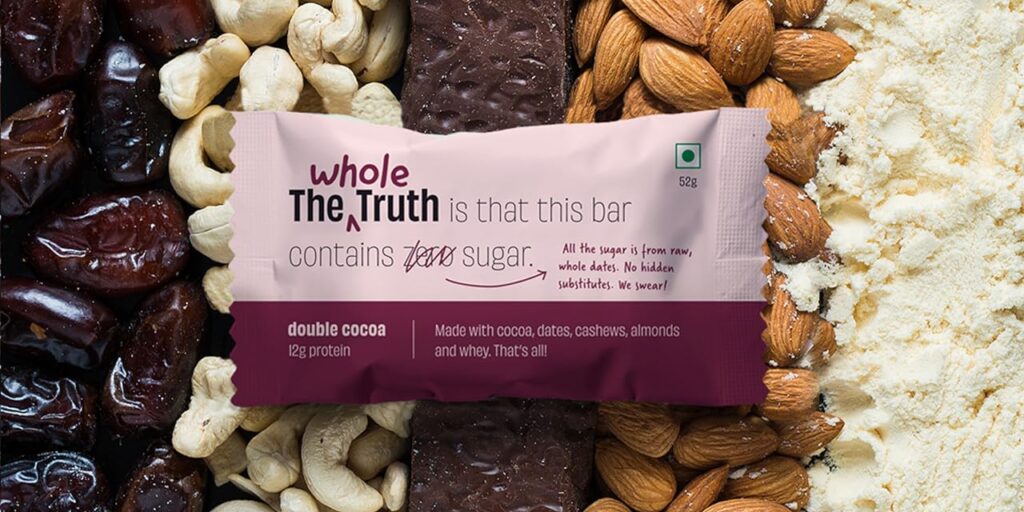Case Study: How “The Whole Truth” is Revolutionizing the Healthy Food Market in India

The global shift towards healthier eating has led to the rapid growth of the healthy food industry worldwide. India, one of the fastest-growing markets in this segment, presents a fascinating case study of how innovation, transparency, and strategic planning can disrupt an industry. One brand leading this transformation is The Whole Truth (TWT). Within just five years, TWT has become a 600-crore direct-to-consumer (D2C) giant, reshaping how consumers perceive packaged healthy food.
This case study dives deep into TWT’s journey, strategies, and insights, offering valuable lessons for entrepreneurs, particularly in the USA, where the healthy food market is already well-established but ripe for differentiation.
The Rapid Growth of India’s Healthy Food Market
India’s healthy food market has undergone a paradigm shift over the last few years:
- Exponential Growth: The market is growing at a rate of 20% annually—the fastest in the world.
- Market Value: Expected to reach $30 billion by 2026, equivalent to the size of India’s footwear market.
- Changing Consumer Habits:
- Increased gym memberships.
- More people counting calories.
- Rising awareness of reading food labels.
Despite this, the penetration of healthy packaged foods in India stands at 11%, compared to 31% in the U.S. This presents a massive growth opportunity, highlighting the potential for startups to thrive in this sector.
The Whole Truth: Born from Frustration
The Whole Truth was founded by Shashank Mehta, whose personal struggles with obesity and dissatisfaction with misleading food labels became the driving force behind the brand. Shashank’s mission was clear: to create a food brand that was completely transparent and committed to using clean, natural ingredients.
The Problem with Packaged Foods
Many food brands globally, including those in the U.S., often mislead consumers with partial truths. For example:
- “Healthy” juices often contain as much sugar as sodas.
- Artificial sweeteners and preservatives are marketed as harmless but can negatively impact health.
Shashank’s vision was to address these issues by creating products that were 100% transparent, free from artificial additives, and focused on clean labeling.
Three Core Insights Behind The Whole Truth’s Success
- Building Trust with Quality
Trust is paramount in the healthy food sector, and TWT built it meticulously:
- In-House Manufacturing: Unlike most brands that outsource manufacturing, TWT opted for in-house production to maintain complete control over quality and innovation.
- Product Purity: Their protein bars, for instance, contain only six ingredients, avoiding artificial binders and sweeteners. They use natural substitutes like dates instead of refined sugars.
- Customer Loyalty: Their focus on quality has resulted in a remarkable 56% repeat purchase rate, far above the industry average of 35%.
Challenges Overcome
- Shelf Life: TWT’s commitment to avoiding preservatives reduces shelf life to six months (compared to competitors’ 12 months), leading to a higher return-from-trade rate of 15%.
- Taste: The natural, less sweetened taste took time for consumers to adapt to, but their target audience valued health over indulgence.
- Mastering Content and Communication
TWT’s content strategy is a masterclass in storytelling, education, and engagement:
- Storytelling:
- The brand name itself communicates transparency.
- Founder Shashank Mehta features prominently in ads, making the brand relatable and authentic.
- Educational Content:
- TWT’s blogs, newsletters, and social media posts debunk myths about “healthy” foods and educate consumers on reading labels.
- Importantly, these educational efforts do not directly promote their products but build trust and awareness.
- Engaging Voice:
- Their witty, conversational tone appeals to Gen Z and millennials, particularly in Tier 1 cities.
- Campaigns like myth-busting influencer culture and demystifying industry jargon resonate with younger audiences.
- Strategic Distribution and SKU Expansion
TWT’s growth strategy combines a focused approach to products and a versatile distribution model:
- Narrow-to-Wide SKU Strategy:
- TWT started with niche products like protein bars and peanut butter, which offered differentiation.
- After establishing brand loyalty, they expanded into broader categories like chocolates, which now rival their initial products in sales.
- Omnichannel Presence:
- Initially an online-only brand, TWT is now present across supermarkets, e-commerce platforms like Amazon, and quick-commerce apps such as Zepto.
- Despite this expansion, 80% of their sales still come from online channels, aligning with the buying habits of their urban, tech-savvy target audience.

Lessons for U.S.-Based Healthy Food Brands
While the Indian and U.S. markets differ, TWT’s strategies offer valuable insights:
- Transparency Wins Loyalty:
- Highlighting every ingredient and avoiding additives builds trust.
- U.S. brands can adopt similar practices to stand out in a saturated market.
- Content is King:
- Educating consumers without overtly promoting products fosters trust.
- Storytelling humanizes the brand and creates stronger connections.
- Focus on Quality, Not Just Taste:
- Health-conscious consumers prioritize clean ingredients over sugary indulgence.
- In-house manufacturing ensures consistent quality and innovation.
- Omnichannel Approach:
- Meet customers where they are, whether online or offline.
- Prioritize e-commerce for tech-savvy audiences while maintaining a presence in physical stores.
Conclusion
The Whole Truth’s journey demonstrates that success in the healthy food market requires more than just a good product. Transparency, strategic growth, and customer-centric content are key drivers of their success. As the global demand for healthy foods continues to rise, brands—in India, the U.S., and beyond—can draw inspiration from TWT’s bold approach to creating a healthier, more informed world.
By focusing on quality and authenticity, brands can not only capture market share but also win the trust and loyalty of health-conscious consumers.
If you want to learn more:https://top9blogs.com/